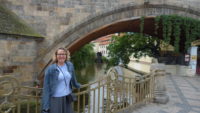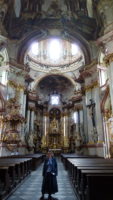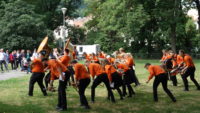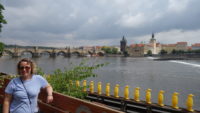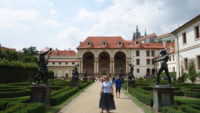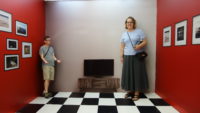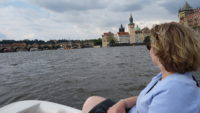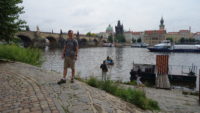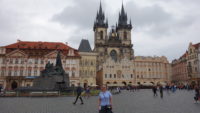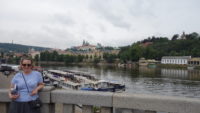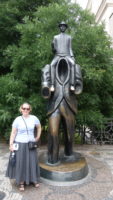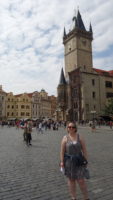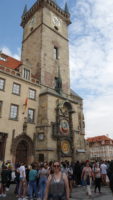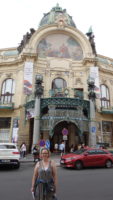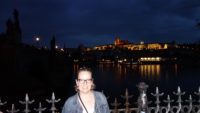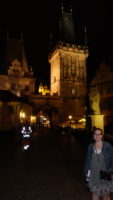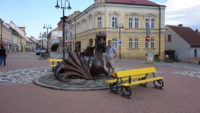 We have two hard-and-fast rules when we are traveling in Europe – you will waste time, and you will waste money. Sometimes things do not go as expected, and you have to swing with it. One of the little joys we have had while traveling has been to go to English-speaking church services on Sundays when it is possible; it requires us to be in-country on a Sunday and to be in a big enough city to support a church that speaks English. Prague qualifies as both, so we found a church near our hostel that had a service at 10:30, and we dutifully arrived at 10:00 to find the doors of the building locked. Since the church met in a commercial building on one of the floors, we thought we might need to buzz in, but we could not find a buzzer. We stood there for a few minutes before we went to a cafe to get on the internet (and have a muffin).
We have two hard-and-fast rules when we are traveling in Europe – you will waste time, and you will waste money. Sometimes things do not go as expected, and you have to swing with it. One of the little joys we have had while traveling has been to go to English-speaking church services on Sundays when it is possible; it requires us to be in-country on a Sunday and to be in a big enough city to support a church that speaks English. Prague qualifies as both, so we found a church near our hostel that had a service at 10:30, and we dutifully arrived at 10:00 to find the doors of the building locked. Since the church met in a commercial building on one of the floors, we thought we might need to buzz in, but we could not find a buzzer. We stood there for a few minutes before we went to a cafe to get on the internet (and have a muffin).
I brought up the church website, and under the worship section it mentioned they now meet at 4:00 pm. Huh. I know I didn’t make up that 10:30 am time out of nowhere. Mer asked to see the computer, and she went to the church homepage, where it said, “Change in worship time June 23rd – 10:30 am”, which I took to mean, “Starting June 23rd, we will be meeting at 10:30, for summer hours.” It turns out they meant, “On June 23rd only, we are worshiping at 10:30 am.” I’m not sure why the June 23rd notice was still online on July 14th, but it meant we missed church – we were too late to get to any of the other services on time, so we went back to the hostel. It was about eighty-five minutes of wasted effort, but you will waste time when traveling.
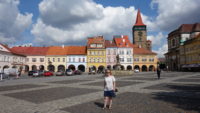 We headed out to the airport to pick up the rental car. Prague is an amazing city, and we did not see anywhere near enough of it, so I am happy we will be back at the end of the trip for a day. We did the tram-subway-subway-bus trip out to the airport, where we picked up our bright green Skoda Fabia, which is the same make of car we had on our Croatia trip three years ago. Skoda is a Czech company, so we are playing to the hometown team.
We headed out to the airport to pick up the rental car. Prague is an amazing city, and we did not see anywhere near enough of it, so I am happy we will be back at the end of the trip for a day. We did the tram-subway-subway-bus trip out to the airport, where we picked up our bright green Skoda Fabia, which is the same make of car we had on our Croatia trip three years ago. Skoda is a Czech company, so we are playing to the hometown team.
My brilliant idea, with which I was very pleased, was to get the car out at the airport (as opposed to in the city) so that I could avoid city driving while getting used to a strange car, and a manual shift one at that. I also brought along our GPS with the additional map on it, which promptly told me to take a right. To the city center. Sigh. I’m not sure where the Hertz office is in the city, but at least the route I did take did not take me too far into downtown before getting me back on a highway.
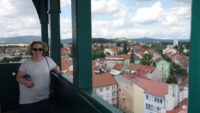 We had an uneventful two-hour drive to our next destination, the town of Jicin, population sixteen thousand. Although that is a bigger number than I would have guessed, the main part of the town where our hotel is located is very small and walkable. We got checked in to the hotel by a very nice clerk who said we were the first Americans he himself had ever checked in. He had a preference for sixties and seventies American rock music, so we did not mind the check-in process at all while we listened to his playlist.
We had an uneventful two-hour drive to our next destination, the town of Jicin, population sixteen thousand. Although that is a bigger number than I would have guessed, the main part of the town where our hotel is located is very small and walkable. We got checked in to the hotel by a very nice clerk who said we were the first Americans he himself had ever checked in. He had a preference for sixties and seventies American rock music, so we did not mind the check-in process at all while we listened to his playlist.
Once settled, we popped next door to a cafe for a snack, based solely on the fact the cafe sign had a cat logo, and there were painted cat paw prints showing the way to the door. We also ran into the first people with whom we’ve interacted in Czechia who spoke no English. Happily, there was one other customer there, and she spoke English, so she helped us, although we did end up with two orders of an excellent hot chocolate instead of one. I did not mind.
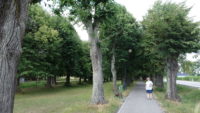 We wandered the center of the town, which is very cute, with colorful buildings and a tower. I saw people walking around up at the top of the tower, so I decided we should do that. I think it cost about $2.50 to go up – it’s not all bad being out of Prague. Near the top of the stairs, the tower opened up to a room which was filled with puppets who seemed to be performing for a king puppet. It was a little odd, as there was no explanation, which we could not have read anyway.
We wandered the center of the town, which is very cute, with colorful buildings and a tower. I saw people walking around up at the top of the tower, so I decided we should do that. I think it cost about $2.50 to go up – it’s not all bad being out of Prague. Near the top of the stairs, the tower opened up to a room which was filled with puppets who seemed to be performing for a king puppet. It was a little odd, as there was no explanation, which we could not have read anyway.
At the top, we paid the admission fee; the clever locals let you climb up to the top before charging you. Are you going to say no at that point? The views from the top were excellent, or so Meredith tells me. I was terrified of the height, and it was all I could do to make it around the perimeter of the tower and take a few photos of Mer before retreating back to the safety of inside the tower, where I happily looked out over the landscape through a window. It was excellent. Mer stayed out for two full circuits of the tower.
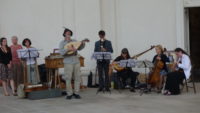 We had been told of a tree-lined alley that we could walk along that ended at a loggia (huge covered porch) that had been built by Waldstein of the Waldstein gardens and palace in Prague. It seems as if he built this and several castles around in the area. So we walked out. And walked. And walked. It turns out the path was about 1.3 miles long, but it did end in the loggia. As we approached, we heard music being played, so we popped up onto the porch to investigate, and there was a small Renaissance-style band playing, with a lute, and recorders, and a cello, and even a hand-pumped organ. We sat and listened to the free concert for about thirty minutes; it was completely unexpected. Just like the huge wind storm that blew in with driving rain. When we were over a mile and a half from our coats and umbrellas. So we waited the rain out, admiring the double rainbow that was produced, and then as I proclaimed we could just about go, we got a boom of thunder and some more rain, but mostly on the town side of the loggia. It was a very tight cloud, it seems. The rain finally stopped, and we headed back to town, dry.
We had been told of a tree-lined alley that we could walk along that ended at a loggia (huge covered porch) that had been built by Waldstein of the Waldstein gardens and palace in Prague. It seems as if he built this and several castles around in the area. So we walked out. And walked. And walked. It turns out the path was about 1.3 miles long, but it did end in the loggia. As we approached, we heard music being played, so we popped up onto the porch to investigate, and there was a small Renaissance-style band playing, with a lute, and recorders, and a cello, and even a hand-pumped organ. We sat and listened to the free concert for about thirty minutes; it was completely unexpected. Just like the huge wind storm that blew in with driving rain. When we were over a mile and a half from our coats and umbrellas. So we waited the rain out, admiring the double rainbow that was produced, and then as I proclaimed we could just about go, we got a boom of thunder and some more rain, but mostly on the town side of the loggia. It was a very tight cloud, it seems. The rain finally stopped, and we headed back to town, dry.
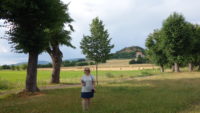 Once we got past the tower, I wanted to see a small park to the left, so we went that way. As we got into the park, we heard music, so we delayed supper and went to investigate. It turned out to be a woman singing with her small guitar band. She was singing Irish songs that we knew, in Czech-accented lyrics, with (presumably) explanations to the audience as to what the songs were about. Probably. Did I mention we don’t speak Czech? We listened for two and a half songs, and then she wrapped up – we had caught the end of the concert, but it still was a delight.
Once we got past the tower, I wanted to see a small park to the left, so we went that way. As we got into the park, we heard music, so we delayed supper and went to investigate. It turned out to be a woman singing with her small guitar band. She was singing Irish songs that we knew, in Czech-accented lyrics, with (presumably) explanations to the audience as to what the songs were about. Probably. Did I mention we don’t speak Czech? We listened for two and a half songs, and then she wrapped up – we had caught the end of the concert, but it still was a delight.
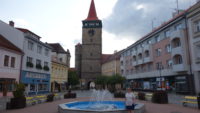 After supper at an Italian restaurant, we went back to the hotel. We missed church and did not miss the city center, but we also stumbled into two unlooked-for concerts. Sometimes things do not go as expected, and that can be a very good thing.
After supper at an Italian restaurant, we went back to the hotel. We missed church and did not miss the city center, but we also stumbled into two unlooked-for concerts. Sometimes things do not go as expected, and that can be a very good thing.
